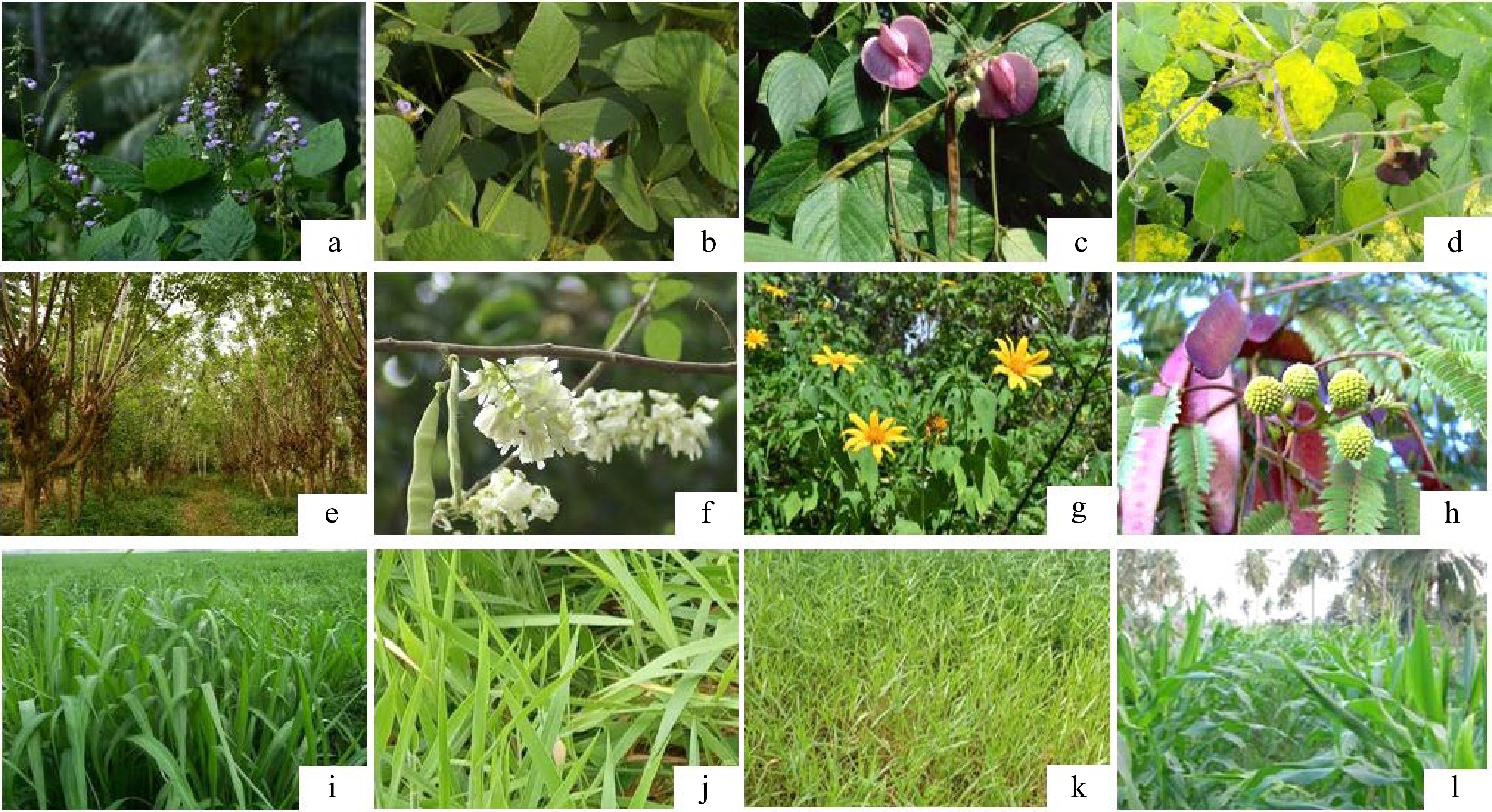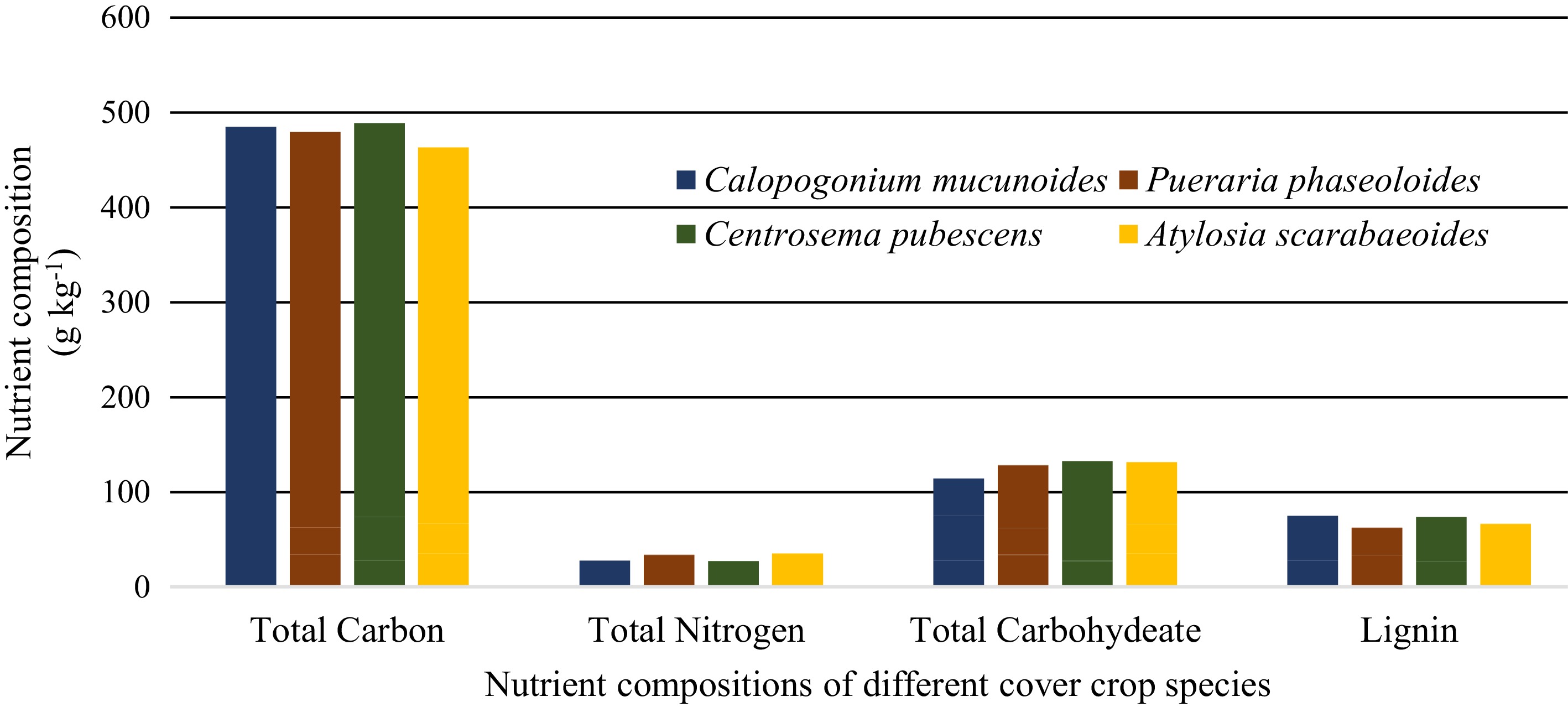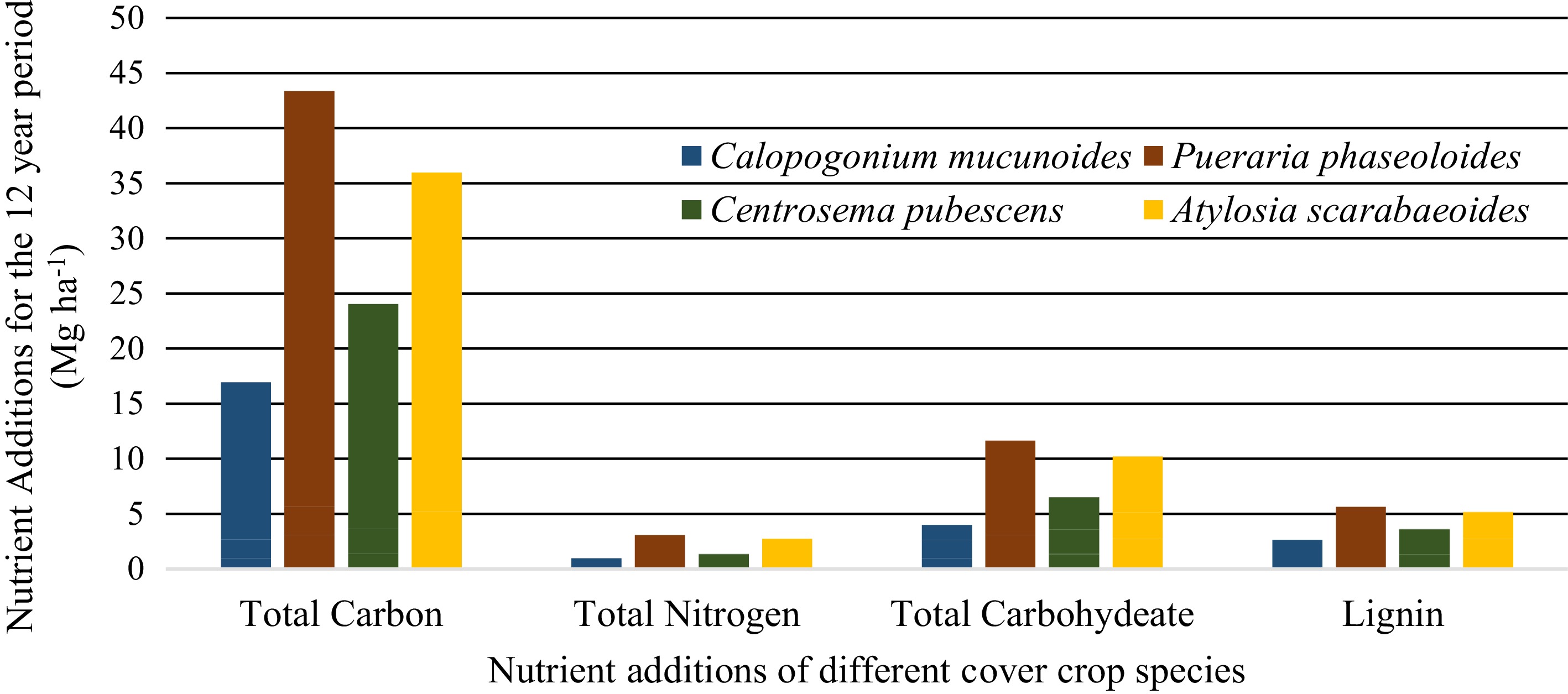-

Figure 1.
Widely cultivated cover crop species in Sri Lanka. (a) Pueraria phaseoloides Roxb. (b) Calopogonium mucunoides. (c) Centrosema pubescens. (d) Macroptilium atropurpureum. (e) Gliricidia sepium. (f) Gliricidia maculata. (g) Tithonia diversifolia. (h) Leucaena leucocephala. (i) Brachiaria brizantha. (j) Brachiaria ruziziensis. (k) Brachiaria milliformis. (l) Zea mays.
-

Figure 2.
Comparison of different weed control methods in coconut plantations[22].
-

Figure 3.
Comparison of nutrient composition of different legume cover crops[28].
-

Figure 4.
Comparison of nutrient additions of different legume cover crops for the 12 y period[28].
-
Family Scientific name Common name Life span Growing habit Fabaceae Pueraria phaseoloides Puero Perennial Climber or creeper Calopogonium mucunoides Calopo Perennial Climber or creeper Centrosema pubescens Centro Perennial Climber or creeper Macroptilium atropurpureum Siratro Perennial Climber or creeper Mucuna spp. Mucuna Perennial Climber or creeper Gliricidia sepium Gliricidia Perennial Tree Gliricidia maculata Gliricidia Perennial Tree Leucaena leucocephala Ipil-ipil Perennial Tree Tithonia diversifolia Wild sunflower Perennial Shrub Crotalaria juncea Sunn hemp Annual Herb Poaceae Brachiaria brizantha Signal grass Perennial Herb Brachiaria ruziziensis Ruzi grass Perennial Herb Brachiaria milliformis Cori grass Perennial Herb Zea mays Fodder-maize Annual Herb -
Cover crop species Suppression % of
grassy weedsSuppression % of
broad-leaf weedsCalopogonium mucunoides 4 96 Mucuna spp. 7 93 Crotalaria juncea 9 91 No cover cropped land 19 81 Table 2.
Weed suppression percentage by different cover crop species in a cotton field[16].
-
Zone in Sri Lanka Microbial activity (mg day−1) 2009 2010 2011 2012 Walpita Research Station
(Wet zone)72.54 76.89 88.36 96.74 Potthukulama Research Station
(Dry zone)48.62 55.22 70.36 68.94 Table 3.
Variation of microbial activity on T. diversifolia added coconut land[15].
-
Treatment Soil bulk density
(g cm−3)Soil moisture content
(%)2010 2011 2012 2010 2011 2012 Coconut with G. sepium 1.49 1.42 1.36 1.44 4.56 2.98 Coconut with P. phaseoloides 1.36 1.32 1.24 3.27 6.78 5.68 Coconut with no cover crop 1.68 1.73 1.69 1.27 2.98 1.58 Table 4.
Effect of cover cropping on soil bulk density and soil moisture content[40].
-
Treatment Nut yield (nuts/palm/year) 2009 2010 2011 2012 Coconut with G. sepium 53 33 68 63 Coconut with P. phaseoloides 51 42 71 68 Coconut with no cover crop 43 32 42 43 Table 5.
Effect of cover cropping on average nut yield[40].
-
Cost Benefits Outputs Outcomes Cost for planting materials Suppressing weeds Enhancing plant growth Increased cost for machinery and other equipment
• Tractors
• Disc-harrowers
• Mammoties
• KnivesModifying soil hydraulic properties
• Enhancing the water infiltration
• Soil moisture conservation
• Reduce soil temperatureLess dependency on chemicals such as
• Pesticides
• Weedicides
• Insecticides
• Synthetic fertilizersIncreased cost for labor for field
activities planting land preparation
fertilization pruning IrrigationIncreasing soil chemical properties
• Supplying nutrients
• Supplying organic matter
• Nitrogen fixationProtect the biodiversity by maximizing the ecosystem services Increased cost for farming practices
• Fertilizing
• IrrigationThe attraction of predators and beneficial insects
such as pollinators, hoverflies, lacewings, ladybirds, parasitic waspsMinimizing land, water, and environmental pollution Knowledge of cover crop species and management practices Minimizing pest and diseases incidence Reduce nutrient leaching Modifying soil physical properties Control sediment and water erosion Habitat for flora and fauna Flood control Modifying soil biological properties Comfort livelihood Source of food, feeding materials, fuel, medicinal and pharmaceutical products, and genetic materials Increasing the resource utilization in the farm field Carbon sequestration Increasing farmers' income Reducing the cost of production Chance for animal husbandry on coconut plantations Less dependency on main cash crop Source for food; milk, meat Reducing the global climate changes Table 6.
Summarization of cost and benefits of cover cropping systems.
-
Management practice Recommendations Reference Integrating ground covers into the farming systems Relay-cropping, over-seeding, inter-seeding, and double-cropping [17] Collection of planting material Seed collection (annual and perennial)
Seeds can be collected from January−March.
Sun-drying for 2−3 days.
Quality seeds should be sorted, packed, and stored properly[50] Collection of cuttings (perennial)
Cutting can be collected from stems of one-year old plants.
Propagating cuttings with adventitious roots are recommended.Land preparation Planting beds can be non-prepared fields or weed-free seedbeds after removing existing plants before seeding. [50] Land preparation is not always necessary (no-tillage)
Selection of methods and conditions can be done by focusing on The properties of the soil The land parameters Availability of planting materials and other inputs.Ploughing, slashing, burning or chemical applications can be practiced for land preparation.
Pre-seeding fertilizer application will be beneficial. As examples,
• Cow dung
• 0.5 kg of Urea, 1−2 kg of Saphos phosphate, and 1 kg of Muriate of Potash per one coconut squareSeed treatment Seeds can be treated with hot water for a few minutes as an easy and low-cost method for breaking seed dormancy. [55] Mechanical methods such as light treatments and scarification with sandpaper or chemical methods like sowing in gibberellic acid and sulfuric acid solutions also can be practiced specifically for legume seeds. [56] Seed coating using bio-stimulants such as microbial inoculants, beneficial bacteria, and fungi, containing compounds, biopolymers, and plant extracts while establishing may increase the germination percentage, seedling vigor, and plant uniformity. [57] Planting and seeding If planting materials are very expensive or unavailable, nurseries can be maintained. [50] Using coconut husks filled with soil and dung mixture or using polythene tubes filled with the above mixture can be used as growing media. Selection of proper seed rate is also important for obtaining optimum cover crop productivity and reducing cost for seeds. This depends on crop species. [58] Row-wise or broadcasting over the entire field can be practiced. Generally, for legumes, 5−6 Kg seeds/ha is recommended for broadcasting as rows, while 8−10 Kg seeds/ha are broadcasting in total space. [50] Drilling, aerial seeding, or broadcasting of seeds can be practiced for planting. Even though broadcasting is easy, drilling shows a faster establishment rate due to higher seed-soil contact. [59] Cover crop management To control the vegetative growth of cover crops;
Use of the 'Mulch roller' or light harrowing once a year or even twice a year can be practiced.
Ploughing once every two years and digging and envelope-forked are recommended.
If it is a bush-type cover crop, like Gliricidia, pruning should be done once plant height reaches about 1.5 m.
[50,60]To facilitate the recovery of these crops;
All these practices should be initiated;
• The onset of rainy periods
• As alternating rows in the field
• Avoid overgrazing in the dry season
• Practice manuringDepending on preferences and other resource availability, two or more cover crop species can be grown on the same land. [61] Controlling cover crops Timing of cover crop termination is critical.
The cover crop should be grown enough to provide adequate nutrients and farmers' objectives but overgrowth should be avoided.[62] Mechanical killing methods like tillage, mowing, undercutting, or rolling can be used. [63] Herbicides are commonly used in inorganic fields. It should be sprayed at the time of flowering when biomass production is greatest.
Although the earlier application may reduce the biomass produced by cover crops, it will improve the control over the difficulties of killing cover crops.[64] Killed biomass can be buried in the soil or scattered on the soil, or converted into the secondary product as compost. [65] Table 7.
Management practices on cover cropping.
Figures
(4)
Tables
(7)